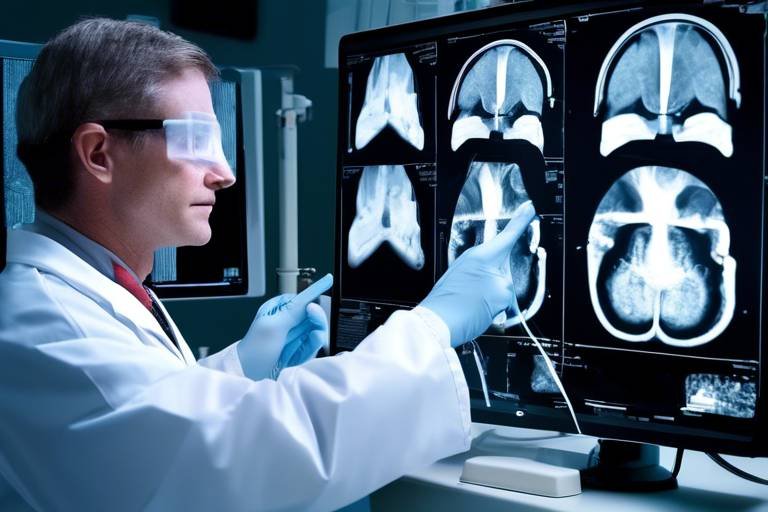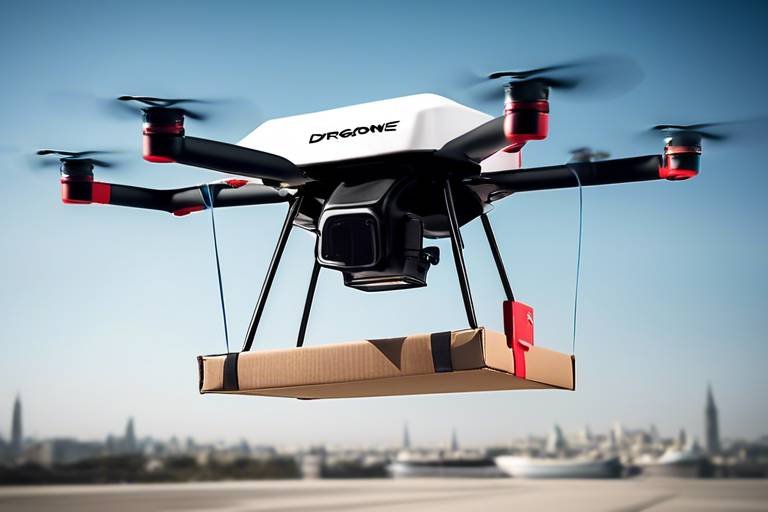Smart Agriculture - Technology's Role in Farming
In today's fast-paced world, the farming industry is undergoing a remarkable transformation, thanks to the integration of advanced technologies. Smart agriculture is not just a buzzword; it’s a revolution that is reshaping how we grow food, manage resources, and ensure sustainability. Imagine a farm where every seed planted is monitored by sensors, where drones fly overhead to assess crop health, and where data analytics help farmers make informed decisions. This is not a scene from a sci-fi movie; it's the new reality of modern farming.
As we delve deeper into the realm of smart agriculture, we uncover a myriad of technologies that are enhancing productivity while promoting environmental stewardship. From precision farming techniques that optimize resource use to the Internet of Things (IoT) that connects devices for seamless data collection, the landscape of agriculture is evolving. Farmers today are equipped with tools that allow them to not only increase their yields but also reduce their carbon footprint.
One of the most exciting aspects of smart agriculture is its ability to address the growing global demand for food. With an ever-increasing population, the pressure on agricultural systems is immense. According to the Food and Agriculture Organization (FAO), food production must increase by 70% by 2050 to meet the needs of the world. This daunting challenge can be met through innovative technologies that enhance efficiency and sustainability in farming practices.
Moreover, smart agriculture is not just about technology; it’s about the farmers who embrace these changes. By adopting new tools and methods, farmers can improve their livelihoods and contribute to a more sustainable future. The integration of technology into agriculture also opens up new avenues for education and training, ensuring that the next generation of farmers is well-equipped to tackle the challenges ahead.
As we explore the various facets of smart agriculture in the sections that follow, we will see how precision farming, drone technology, IoT, vertical farming, and blockchain are not just trends but essential components of a sustainable agricultural ecosystem. These innovations are paving the way for a future where farming is not only productive but also environmentally friendly and socially responsible.
- What is smart agriculture? Smart agriculture refers to the use of advanced technologies to improve farming practices, enhance productivity, and promote sustainability.
- How does precision farming work? Precision farming utilizes data and technology to optimize field-level management, increasing crop yields while minimizing environmental impact.
- What role do drones play in agriculture? Drones provide aerial imagery and data collection, helping farmers monitor crop health, assess field conditions, and manage resources efficiently.
- What is IoT in agriculture? The Internet of Things (IoT) connects devices and sensors to gather data from the field, enhancing decision-making and operational efficiency.
- How does vertical farming benefit urban areas? Vertical farming maximizes space and resource efficiency, making it ideal for urban areas with limited land availability.

Precision Farming
is a game-changer in the agricultural landscape, revolutionizing the way farmers approach cultivation. Imagine being able to manage your fields with the same precision as a surgeon operating on a patient. That's what precision farming offers! By utilizing advanced data and technology, farmers can optimize field-level management, leading to increased crop yields and a significant reduction in environmental impact.
This innovative approach is all about using data-driven insights to make informed decisions. For instance, farmers can now analyze soil health, moisture levels, and nutrient requirements in real-time. This allows them to apply fertilizers and pesticides only where needed, minimizing waste and promoting sustainable practices. In essence, precision farming is like having a GPS for your crops, guiding you to the best practices for maximum yield.
One of the standout features of precision farming is its ability to enhance resource efficiency. Here’s how it works:
- Data Collection: Sensors and drones gather data on various environmental factors, providing a comprehensive overview of the field.
- Analysis: Advanced analytics tools process this data, revealing patterns and trends that can inform farming decisions.
- Action: Armed with these insights, farmers can make real-time adjustments to their practices, whether it’s changing irrigation schedules or deciding when to plant or harvest.
Moreover, the integration of precision farming technologies leads to a notable reduction in costs. By optimizing inputs and minimizing waste, farmers can save money while still achieving high productivity levels. It's a win-win situation! For example, a study showed that farms utilizing precision techniques saw a 20% increase in yields while reducing their fertilizer usage by 30%.
As we look to the future, the potential of precision farming is enormous. With the ongoing advancements in technology, such as artificial intelligence and machine learning, we can expect even more sophisticated tools that will further enhance productivity and sustainability in agriculture. The question isn't whether precision farming will shape the future of agriculture, but rather how quickly it will become the norm.
In conclusion, precision farming is not just a trend; it's a necessary evolution in the way we approach food production. By embracing these technologies, farmers can not only improve their bottom line but also contribute to a more sustainable and resilient agricultural system. The future of farming is here, and it's more precise than ever!

Drone Technology
Drone technology is rapidly transforming the landscape of agriculture, offering farmers innovative tools to enhance productivity and efficiency. These unmanned aerial vehicles (UAVs) are no longer just a novelty; they have become a game changer in modern farming. By providing aerial imagery and data collection capabilities, drones allow farmers to monitor their crops and fields like never before. Imagine being able to survey hundreds of acres in a matter of minutes, gaining insights that would typically take days or even weeks to gather through traditional methods.
One of the most significant advantages of using drones in agriculture is their ability to conduct crop monitoring. With high-resolution cameras and sensors, drones can capture detailed images of crops, enabling farmers to identify potential issues such as pests, diseases, or nutrient deficiencies early on. This proactive approach not only leads to timely interventions but also fosters better overall crop management. For instance, a farmer who uses drones can spot a small patch of diseased plants and take action before the problem spreads, saving both time and resources.
Furthermore, the integration of data analytics tools with drone technology amplifies its benefits. The data collected by drones is processed to provide actionable insights into crop performance. Farmers can analyze trends and patterns, making informed decisions based on real-time data. This capability is akin to having a personal assistant who not only gathers information but also interprets it to suggest the best course of action. Imagine knowing exactly when to water your crops or when to apply fertilizers, all based on precise data rather than guesswork.
Another compelling aspect of drone technology is its impact on cost efficiency. Implementing drones may seem like a significant investment initially, but the long-term savings are substantial. By streamlining processes and improving resource allocation, farmers can reduce operational costs dramatically. For example, drones can help optimize pesticide usage by applying it only where needed, minimizing waste and lowering expenses. This level of efficiency translates directly into better financial outcomes without sacrificing productivity.
Additionally, drones facilitate field mapping, which is essential for effective land management. By creating detailed maps of the land's topography and soil health, farmers can make informed decisions about planting strategies and resource allocation. This information is crucial in ensuring that crops are planted in the most suitable areas, maximizing yield potential while minimizing environmental impact. With drones, farmers can visualize their fields in a way that was previously unimaginable, leading to smarter, more sustainable farming practices.
In summary, the role of drone technology in agriculture is pivotal. It empowers farmers with the tools needed to monitor crop health, analyze data, and make informed decisions that enhance productivity and sustainability. As this technology continues to evolve, we can expect even more innovations that will further revolutionize the agricultural sector, making it more efficient and environmentally friendly.
- What types of drones are used in agriculture? There are various types of drones used in agriculture, including fixed-wing drones for large areas and multi-rotor drones for precision tasks.
- How can drones improve crop health monitoring? Drones equipped with multispectral cameras can detect variations in plant health, allowing for early intervention.
- Are drones cost-effective for small farms? Yes, while the initial investment may be high, the long-term savings and increased efficiency can benefit small farms significantly.

Crop Monitoring
Crop monitoring has become an essential practice in modern agriculture, thanks to the advent of drone technology. Imagine being able to survey vast fields from the sky, spotting potential issues before they escalate into major problems. This is precisely what drones offer—an aerial perspective that traditional methods simply cannot match. By utilizing high-resolution imagery, farmers can gain insights into crop health, moisture levels, and even nutrient deficiencies, allowing for timely interventions that can save both time and resources.
One of the most significant advantages of drone-assisted crop monitoring is the ability to conduct real-time assessments. Farmers can quickly identify areas that require immediate attention, whether it’s a pest invasion or a disease outbreak. For instance, by analyzing drone data, a farmer might discover that a specific section of their field is exhibiting signs of stress due to insufficient irrigation. This early detection means they can act swiftly, applying water or pesticides only where necessary, thus minimizing waste and maximizing yield.
Furthermore, the data collected by drones can be integrated with advanced data analytics tools. These tools process the information gathered, providing farmers with actionable insights that enhance their decision-making processes. For example, a farmer can utilize this data to determine the most effective times for planting and harvesting, ultimately leading to increased productivity. This proactive approach to crop management not only boosts yields but also promotes sustainability, as it reduces the need for excessive chemical inputs.
To illustrate the effectiveness of crop monitoring, consider the following table that highlights the benefits of drone technology in agriculture:
| Benefit | Description |
|---|---|
| Early Detection | Identify issues like pests or diseases before they spread. |
| Resource Optimization | Apply water and nutrients only where needed, reducing waste. |
| Informed Decision-Making | Utilize data analytics for better planning and management. |
| Increased Yields | Boost crop production through timely interventions. |
In conclusion, crop monitoring through drone technology is not just a trend; it’s a transformative practice that is reshaping the landscape of agriculture. By harnessing the power of aerial data, farmers can enhance their productivity while promoting sustainable practices. So, if you’re still relying on outdated methods, it might be time to consider the sky-high advantages of drone technology!
- What is crop monitoring? Crop monitoring refers to the practice of observing and assessing the health and status of crops using various technologies, including drones.
- How do drones help in crop monitoring? Drones provide aerial imagery and data collection, allowing farmers to quickly identify issues like pests, diseases, and irrigation problems.
- Can crop monitoring improve yields? Yes, by enabling early detection of issues and facilitating informed decision-making, crop monitoring can significantly increase yields.
- Is crop monitoring cost-effective? While there may be initial costs associated with drone technology, the long-term savings from optimized resource use and increased productivity often outweigh these costs.

Data Analytics
In the realm of smart agriculture, stands out as a game-changer. Imagine being able to sift through mountains of data collected from various sources—drones, IoT devices, and even weather forecasts—to uncover patterns that can significantly enhance your farming practices. This is precisely what data analytics offers to modern farmers. By leveraging advanced algorithms and machine learning techniques, farmers can analyze data to gain insights into crop performance, resource allocation, and potential yield predictions.
For instance, when data from drones is processed, it can reveal crucial information such as soil health, moisture levels, and even pest activity. This allows farmers to make informed decisions that can lead to better crop management. Instead of waiting for issues to arise, farmers can take a proactive approach. They can identify areas that need attention, whether it’s adjusting irrigation schedules or applying fertilizers more effectively. The result? Enhanced productivity and healthier crops.
But how does this all work? Let’s break it down:
- Real-Time Monitoring: Data analytics enables farmers to monitor their fields in real-time, allowing for immediate action when problems are detected.
- Predictive Analysis: By analyzing historical data, farmers can predict future trends, such as potential crop yields or the likelihood of pest infestations.
- Resource Optimization: Data helps in optimizing inputs like water, fertilizers, and pesticides, ensuring that resources are used efficiently and sustainably.
Moreover, the integration of data analytics into farming isn’t just about increasing yields; it’s also about sustainability. By making smarter decisions based on data, farmers can reduce waste and minimize their environmental impact. For example, through precise data analysis, a farmer can determine the exact amount of water needed for their crops, reducing excessive irrigation and conserving precious water resources.
In addition, data analytics can also enhance collaboration within the agricultural community. Farmers can share insights and data findings with each other, creating a network of knowledge that benefits everyone involved. This collective intelligence can lead to innovations that further push the boundaries of what is possible in agriculture.
To summarize, data analytics in agriculture is like having a crystal ball that provides clarity in a field often clouded by uncertainty. It empowers farmers to make decisions that are not only profitable but also environmentally responsible. As technology continues to advance, the role of data analytics in agriculture will only grow, promising a future where farming is more efficient, sustainable, and productive than ever before.
Q1: What is data analytics in agriculture?
Data analytics in agriculture refers to the process of collecting and analyzing data from various sources to improve farming practices, enhance productivity, and promote sustainability.
Q2: How can data analytics help farmers?
Data analytics helps farmers by providing insights into crop performance, optimizing resource usage, predicting future trends, and enabling real-time monitoring of field conditions.
Q3: Is data analytics expensive for farmers?
While there may be initial costs associated with implementing data analytics tools, the long-term benefits, such as increased yields and reduced waste, often outweigh these costs.
Q4: Can small-scale farmers benefit from data analytics?
Absolutely! Data analytics can be tailored to meet the needs of small-scale farmers, helping them make informed decisions that lead to improved productivity and sustainability.

Cost Efficiency
In today's fast-paced agricultural landscape, has become a pivotal factor for farmers aiming to enhance their profitability while maintaining sustainability. The integration of drone technology in farming practices plays a significant role in achieving this goal. By utilizing drones, farmers can streamline various processes that traditionally consumed a lot of time and resources.
For instance, the ability to conduct aerial surveys and gather data on crop health allows farmers to make informed decisions that can prevent costly mistakes. Imagine a farmer who, without drone technology, would need to walk through vast fields to assess crop conditions. This not only takes hours but also increases the likelihood of overlooking critical issues. With drones, however, farmers can quickly gather comprehensive data, enabling them to focus their efforts on areas that truly need attention.
Moreover, the operational costs associated with traditional farming methods can be significantly reduced through the adoption of drone technology. Here are some key areas where savings can be realized:
- Labor Costs: Drones can reduce the need for manual labor by automating tasks such as crop monitoring and field mapping.
- Resource Allocation: By providing precise data, drones help farmers allocate resources like water and fertilizers more efficiently, thus minimizing waste.
- Time Savings: The speed at which drones can gather data means that farmers can make quicker decisions, leading to faster implementation of crop management strategies.
To illustrate the potential savings from implementing drone technology, consider the following table:
| Traditional Method | Drone Technology | Cost Savings |
|---|---|---|
| Manual Crop Monitoring | Aerial Surveys | 30% Reduction in Labor Costs |
| General Resource Usage | Data-Driven Resource Allocation | 20% Reduction in Water and Fertilizer Costs |
| Slow Decision Making | Real-Time Data Analysis | 15% Increase in Crop Yields |
As evidenced by the data, the transition to drone technology not only enhances operational efficiency but also translates into tangible financial benefits for farmers. This shift towards a more cost-effective approach is crucial for maintaining competitiveness in an ever-evolving market.
In conclusion, the cost efficiency afforded by drone technology is not just a fleeting trend; it represents a fundamental shift in how agriculture can be practiced. Farmers who embrace these innovations are not only investing in their immediate success but also in the long-term sustainability of their operations. As the agricultural sector continues to evolve, those who leverage technology effectively will undoubtedly lead the way toward a more productive and sustainable future.
- What are the main benefits of using drones in agriculture?
Drones provide efficient crop monitoring, reduce labor costs, and enhance resource allocation, leading to significant cost savings. - How can drone technology improve crop yields?
By offering real-time data and insights, drones allow farmers to make timely decisions that enhance crop management and ultimately increase yields. - Is drone technology suitable for small-scale farmers?
Absolutely! Drones can be scaled to fit the needs of small farms, making advanced agricultural practices accessible to all.

Field Mapping
Field mapping is a game-changer in the realm of agriculture, allowing farmers to visualize and analyze their land like never before. Imagine having a detailed map of your farm that not only shows the layout but also highlights crucial factors such as soil health, moisture levels, and crop distribution. This kind of insight is invaluable, especially when it comes to making informed decisions about planting and resource allocation.
Using drone technology for field mapping, farmers can create high-resolution maps that provide a comprehensive overview of their fields. These maps can reveal variations in soil type, nutrient levels, and even areas that may require additional care or attention. By understanding the specific needs of different sections of their land, farmers can tailor their approach, ensuring that each crop receives exactly what it needs to thrive.
Moreover, field mapping can significantly enhance the efficiency of farming operations. For instance, when farmers know where the healthiest soil is located, they can prioritize those areas for planting high-value crops. This targeted approach not only maximizes yield but also minimizes waste, as resources are allocated more effectively. In essence, field mapping transforms farming from a one-size-fits-all approach into a more precise and strategic endeavor.
To illustrate the impact of field mapping, consider the following table that outlines the benefits:
| Benefit | Description |
|---|---|
| Enhanced Crop Management | Allows for targeted interventions based on specific field conditions. |
| Resource Optimization | Improves allocation of water, fertilizers, and pesticides, reducing waste. |
| Increased Yield | By understanding soil and crop needs, farmers can boost overall productivity. |
| Cost Savings | Reduces operational costs through efficient resource management. |
In conclusion, field mapping is not just a technological advancement; it’s a revolution in how we approach agriculture. By leveraging this technology, farmers can make data-driven decisions that lead to sustainable practices, enhanced productivity, and ultimately, a healthier planet. The future of farming is here, and it’s all about working smarter, not harder.
- What is field mapping? Field mapping is the process of creating detailed maps of agricultural land using technology, particularly drones, to analyze soil health, moisture levels, and other critical factors.
- How does field mapping benefit farmers? It helps farmers optimize resource allocation, increase crop yields, and make informed decisions about planting and management practices.
- Can field mapping reduce costs? Yes, by improving efficiency and resource management, field mapping can lead to significant cost savings for farmers.
- Is field mapping suitable for all types of farms? Absolutely! Field mapping can be beneficial for farms of all sizes and types, from small family farms to large commercial operations.

IoT in Agriculture
This article explores how technology is transforming farming practices, enhancing productivity, and promoting sustainability. It delves into various innovations that are shaping the future of agriculture.
Precision farming utilizes data and technology to optimize field-level management. This approach increases crop yields while minimizing environmental impact and resource usage, leading to more sustainable agricultural practices.
Drones are revolutionizing agriculture by providing aerial imagery and data collection. They help farmers monitor crop health, assess field conditions, and manage resources more efficiently, ultimately boosting productivity.
Using drones for crop monitoring allows farmers to identify issues such as pests or diseases early on. This proactive approach can lead to timely interventions and better overall crop management.
Data analytics tools process the information collected by drones, providing insights into crop performance. Farmers can make informed decisions based on real-time data, enhancing their farming strategies.
Implementing drone technology can significantly reduce operational costs. By streamlining processes and improving resource allocation, farmers can achieve better financial outcomes while maintaining high productivity.
Drones facilitate detailed field mapping, allowing farmers to visualize their land's topography and soil health. This information is crucial for making informed decisions about planting and resource allocation.
The Internet of Things (IoT) is a game-changer in the agricultural sector, connecting devices and sensors to gather data from the field. Imagine a farm where every plant and animal communicates vital information back to the farmer! This technology enhances decision-making and operational efficiency, contributing to smarter farming practices. With IoT, farmers can monitor everything from soil moisture levels to livestock health in real-time, making it easier to respond to the changing needs of their crops and animals.
One of the standout applications of IoT in agriculture is the development of smart irrigation systems. These systems optimize water usage by continuously monitoring soil moisture levels. By ensuring that crops receive just the right amount of water, farmers can significantly reduce waste and promote sustainable water management. For instance, if the soil moisture dips below a certain threshold, the system can automatically activate, delivering water precisely when it’s needed. This not only conserves water but also helps in maintaining optimal crop health.
In addition to crops, IoT devices are transforming livestock management. Farmers can now track the health and location of their animals with remarkable precision. Imagine wearing a smart collar that sends alerts if a cow is sick or straying too far from the herd! This technology improves productivity and welfare while reducing the risk of disease outbreaks. By analyzing data on livestock behavior and health, farmers can make informed decisions that enhance the overall well-being of their animals.
Vertical farming utilizes technology to grow crops in stacked layers, maximizing space and resource efficiency. This innovative approach is particularly beneficial in urban areas with limited land availability.
Hydroponics and aeroponics are soil-less farming methods that use nutrient-rich water solutions. These techniques can significantly increase crop yields and reduce water usage compared to traditional farming.
Vertical farms often incorporate renewable energy sources, reducing their carbon footprint. This commitment to sustainability aligns with the growing demand for eco-friendly agricultural practices.
Blockchain technology enhances transparency and traceability in the agricultural supply chain. It ensures that consumers can access reliable information about the origin and quality of their food.
By tracking products through the supply chain, blockchain improves food safety. It enables quicker responses to contamination or quality issues, protecting consumers and maintaining trust in the food system.
Blockchain can support fair trade by ensuring that farmers receive fair compensation for their products. This technology promotes ethical practices and strengthens the relationship between producers and consumers.
- What is smart agriculture? Smart agriculture refers to the use of technology and data analysis to improve farming practices, increase productivity, and promote sustainability.
- How does IoT improve farming? IoT enhances farming by connecting devices and sensors to monitor conditions in real-time, leading to better decision-making and resource management.
- What are the benefits of drone technology in agriculture? Drones provide aerial imagery for crop monitoring, assist in field mapping, and help in early detection of issues, ultimately boosting productivity.
- What is vertical farming? Vertical farming is a method of growing crops in stacked layers, often using hydroponics or aeroponics, which maximizes space and resource efficiency.

Smart Irrigation Systems
Imagine a world where your crops receive just the right amount of water they need, no more, no less. are making this dream a reality by utilizing cutting-edge technology to monitor soil moisture levels and automate watering schedules. This innovative approach not only conserves precious water resources but also enhances crop health and yield. By integrating sensors and IoT devices, farmers can effortlessly manage their irrigation systems from the comfort of their homes or even on-the-go.
These systems operate on the principle of precision agriculture, which focuses on maximizing efficiency and minimizing waste. Through real-time data collection, smart irrigation systems can determine when and how much water is required for specific crops. For instance, if a sensor detects that the soil moisture is below a certain threshold, it will automatically trigger the irrigation system to deliver water. This level of automation is a game-changer, allowing farmers to save time and reduce labor costs.
Furthermore, smart irrigation systems can be tailored to fit various farming environments. Whether you're managing a sprawling field or a small urban garden, these systems can be customized to meet your specific needs. Some of the key features include:
- Weather Integration: Many smart irrigation systems can connect to weather forecasts, adjusting watering schedules based on predicted rainfall or temperature changes.
- Remote Monitoring: Farmers can monitor their irrigation systems remotely, receiving alerts and notifications about any issues that may arise.
- Data Analytics: By analyzing historical data, these systems can provide insights into optimal watering practices and help farmers make informed decisions.
To put things into perspective, consider a typical farm with traditional irrigation methods versus one equipped with smart irrigation technology. The former might waste a significant amount of water due to overwatering or inefficient scheduling. In contrast, the latter can achieve up to a 30-50% reduction in water usage while simultaneously improving crop yields. This not only benefits the farmer's bottom line but also contributes to sustainable agricultural practices.
In conclusion, smart irrigation systems are revolutionizing the way we approach water management in agriculture. By leveraging technology, farmers can ensure their crops receive the optimal amount of water, ultimately leading to healthier plants and increased productivity. As we continue to face challenges related to water scarcity and climate change, adopting these innovative solutions is not just beneficial—it's essential for the future of farming.
Q: How do smart irrigation systems save water?
A: Smart irrigation systems use sensors to monitor soil moisture levels and only water crops when necessary, significantly reducing water waste.
Q: Can I control my smart irrigation system remotely?
A: Yes, many smart irrigation systems come with mobile apps that allow you to monitor and control your system from anywhere.
Q: Are smart irrigation systems expensive to install?
A: While the initial investment may be higher than traditional systems, the long-term savings in water and labor costs often make them more economical.
Q: Do smart irrigation systems require a lot of maintenance?
A: Generally, smart irrigation systems are designed to be low-maintenance, but regular checks on sensors and connections are recommended to ensure optimal performance.

Livestock Monitoring
In the realm of modern agriculture, has emerged as a game changer, thanks to the integration of IoT technology. Imagine a world where farmers can keep a close eye on their animals without having to be physically present. This is not just a dream; it’s a reality made possible by smart sensors and connected devices. By leveraging these technologies, farmers can track various aspects of their livestock's health and behavior, ensuring that every animal is thriving.
One of the most significant advantages of livestock monitoring systems is their ability to provide real-time data. These systems can monitor vital signs such as heart rate, temperature, and activity levels. For instance, if a cow’s temperature rises above a certain threshold, it could indicate illness or distress. With this information at their fingertips, farmers can act swiftly, potentially saving the life of an animal and reducing the risk of disease spreading through the herd.
Moreover, these monitoring systems can also track the location of livestock, which is particularly beneficial for farmers with large expanses of land. Imagine being able to locate a stray sheep or cow with just a few taps on your smartphone! This not only saves time but also enhances the overall management of the farm. Farmers can use geolocation data to ensure that their animals are grazing in optimal areas, reducing overgrazing and promoting sustainable land use.
Another crucial aspect of livestock monitoring is its role in improving productivity. By keeping a close watch on the health and behavior of animals, farmers can identify patterns that lead to better breeding practices. For example, data collected over time can reveal the best times for breeding, which can enhance the genetic quality of the herd. This level of insight allows farmers to make informed decisions that directly impact their bottom line.
Furthermore, livestock monitoring contributes to animal welfare. By having access to continuous data, farmers can ensure that their animals are not only healthy but also happy. Stress levels can be monitored through behavioral analysis, allowing farmers to create a more comfortable environment for their livestock. This holistic approach to farming not only benefits the animals but also resonates with consumers who are increasingly concerned about the ethical treatment of farm animals.
In conclusion, powered by IoT technology is revolutionizing the way farmers manage their herds. By utilizing real-time data, farmers can enhance productivity, improve animal welfare, and ensure better health outcomes for their livestock. As technology continues to advance, we can expect even more innovative solutions that will help farmers navigate the challenges of modern agriculture.
- What is livestock monitoring?
Livestock monitoring involves using technology to track the health, location, and behavior of farm animals in real-time.
- How does IoT improve livestock monitoring?
IoT devices collect data on various health metrics and location, allowing farmers to make informed decisions quickly.
- What are the benefits of livestock monitoring?
Benefits include improved animal health, enhanced productivity, better breeding practices, and increased animal welfare.
- Can livestock monitoring reduce costs?
Yes, by preventing disease outbreaks and optimizing resource use, livestock monitoring can lead to significant cost savings for farmers.

Vertical Farming
is a groundbreaking approach that leverages technology to cultivate crops in stacked layers, maximizing both space and resource efficiency. Imagine transforming a small urban footprint into a lush, green oasis where food grows skyward instead of outward. This innovative technique is particularly advantageous in densely populated areas where traditional farming is simply not feasible. By utilizing controlled environments, vertical farms can produce food year-round, irrespective of the external climate conditions.
One of the most fascinating aspects of vertical farming is its ability to significantly reduce the amount of water used compared to conventional farming. Traditional agriculture can consume vast amounts of water, often leading to wastage. In contrast, vertical farms employ advanced hydroponic and aeroponic systems, which use nutrient-rich water solutions to nourish plants directly at their roots. This method not only conserves water but also enhances crop yields, making it a win-win for both farmers and the environment.
Furthermore, vertical farms often incorporate renewable energy sources such as solar panels and wind turbines. This commitment to sustainability not only reduces their carbon footprint but also aligns with the growing demand for eco-friendly agricultural practices. By harnessing the power of the sun and wind, vertical farms can operate with minimal reliance on fossil fuels, contributing to a greener planet.
In addition to water and energy efficiency, vertical farming offers a solution to the challenge of food security. With the global population expected to reach nearly 10 billion by 2050, traditional farming methods may not suffice to meet the increasing food demand. Vertical farming can help bridge this gap by producing fresh, local produce that reduces the need for transportation, thus lowering emissions and ensuring that food is available right where it is needed.
Here's a quick overview of the key benefits of vertical farming:
- Space Efficiency: Maximizes crop production in limited areas.
- Water Conservation: Uses up to 90% less water than traditional farming.
- Year-Round Production: Grows crops regardless of season or weather.
- Reduced Transportation Emissions: Local production minimizes the carbon footprint.
- Enhanced Food Security: Provides a sustainable solution to feeding a growing population.
As we look to the future, the potential of vertical farming is immense. It represents a shift in how we think about food production, sustainability, and urban living. By embracing this innovative method, we can create a more resilient food system that not only meets the needs of today but also paves the way for a sustainable tomorrow.
Q1: What is vertical farming?
A1: Vertical farming is an innovative agricultural practice that involves growing crops in stacked layers, often using controlled environments to optimize growth and resource usage.
Q2: How does vertical farming save water?
A2: Vertical farming uses hydroponic and aeroponic systems that deliver nutrient-rich water directly to plants, significantly reducing water consumption compared to traditional farming methods.
Q3: Can vertical farming be done in urban areas?
A3: Yes! Vertical farming is particularly beneficial in urban settings where space is limited, allowing for local food production right where it is needed.
Q4: What crops can be grown in vertical farms?
A4: A wide variety of crops can be grown in vertical farms, including leafy greens, herbs, and even some fruits. The controlled environment allows for optimal growth conditions.
Q5: Is vertical farming environmentally friendly?
A5: Yes, vertical farming can be environmentally friendly as it often uses renewable energy sources, reduces transportation emissions, and conserves water.

Hydroponics and Aeroponics
When it comes to innovative farming techniques, hydroponics and aeroponics are leading the charge in transforming how we think about agriculture. These methods are not just buzzwords; they represent a radical shift from traditional soil-based farming to more efficient, soil-less systems. Imagine cultivating fresh, vibrant crops without the constraints of land quality or climate conditions! This is precisely what hydroponics and aeroponics offer.
Hydroponics involves growing plants in a nutrient-rich water solution, allowing for direct access to essential nutrients while eliminating the need for soil. This method can significantly enhance crop yields, as plants can grow faster and more robustly in a controlled environment. On the other hand, aeroponics takes it a step further by suspending plants in air and misting their roots with a nutrient solution. This technique not only conserves water but also maximizes oxygen exposure, promoting even healthier growth. Both systems are particularly advantageous in urban areas where space is at a premium.
One of the most exciting aspects of hydroponics and aeroponics is their potential for sustainability. By using these methods, farmers can:
- Reduce water usage by up to 90% compared to traditional farming.
- Minimize the need for pesticides and herbicides, leading to healthier produce.
- Grow crops year-round, regardless of seasonal changes.
Moreover, these systems can be easily implemented in controlled environments such as greenhouses or indoor farms, making them ideal for urban settings where land is scarce. The ability to produce food locally reduces transportation costs and carbon footprints, contributing to a more sustainable food system. As cities continue to grow, the significance of these methods will only increase.
However, it's essential to consider the initial investment and technical knowledge required to set up hydroponic or aeroponic systems. While they can be incredibly efficient, they also require careful monitoring of nutrient levels and environmental conditions. But for those willing to embrace this technology, the rewards can be substantial, not just in terms of yield but also in contributing to a more sustainable future.
In conclusion, hydroponics and aeroponics are not just trends; they are the future of farming. As we face challenges like climate change and urbanization, these innovative methods provide viable solutions for producing food sustainably and efficiently. The question isn't whether we will adopt these technologies, but rather how quickly we can integrate them into our agricultural practices.
Here are some common questions regarding hydroponics and aeroponics:
- What crops can be grown using hydroponics and aeroponics?
Most leafy greens, herbs, and even some fruits can thrive in these systems. Popular choices include lettuce, basil, and strawberries. - Are hydroponic and aeroponic systems expensive to set up?
While the initial costs can be higher than traditional farming methods, the long-term savings in water and resources, along with increased yields, often offset these expenses. - Do these systems require a lot of maintenance?
Yes, regular monitoring of nutrient levels, pH, and environmental conditions is crucial for success. However, many find the rewards worth the effort!

Energy Efficiency
In the ever-evolving landscape of agriculture, has emerged as a crucial factor in ensuring sustainable practices. Vertical farms are at the forefront of this revolution, utilizing innovative technologies that significantly reduce energy consumption while maximizing output. Imagine a farm where crops grow in stacked layers, illuminated by energy-efficient LED lights that mimic natural sunlight. This setup not only saves on electricity costs but also allows for year-round production, regardless of the external climate.
One of the most exciting aspects of energy efficiency in vertical farming is the integration of renewable energy sources. Many vertical farms are now harnessing solar panels to power their operations. This not only reduces reliance on fossil fuels but also lowers greenhouse gas emissions, contributing to a healthier planet. According to recent studies, farms that implement solar energy can cut their energy costs by up to 50%. This is a game-changer for farmers looking to enhance their profitability while being environmentally conscious.
Additionally, energy-efficient technologies extend beyond just renewable sources. Advanced climate control systems are being implemented to optimize the growing environment. These systems can adjust temperature, humidity, and light levels based on real-time data, ensuring that crops receive the ideal conditions for growth without wasting energy. For instance, automated systems can reduce heating costs during the night when temperatures drop, creating a more balanced and cost-effective growing environment.
To illustrate the impact of energy efficiency in vertical farming, consider the following table:
| Technology | Energy Savings (%) | Environmental Impact |
|---|---|---|
| LED Grow Lights | 50-70% | Lower carbon footprint |
| Solar Panels | 30-50% | Reduced greenhouse gas emissions |
| Climate Control Systems | 20-40% | Minimized energy waste |
Furthermore, the commitment to energy efficiency aligns seamlessly with the growing demand for eco-friendly agricultural practices. Consumers are increasingly aware of the environmental impact of their food choices, and they are seeking products that are grown sustainably. By adopting energy-efficient technologies, farmers not only improve their bottom line but also enhance their brand image, appealing to a market that values sustainability.
In conclusion, energy efficiency in vertical farming is not merely a trend; it is a necessity for the future of agriculture. As we continue to face challenges such as climate change and resource scarcity, leveraging advanced technologies to optimize energy use will play a pivotal role in shaping a more sustainable and productive agricultural landscape.
- What is vertical farming? Vertical farming is an innovative agricultural practice that involves growing crops in stacked layers, often utilizing controlled environments to maximize space and resource efficiency.
- How does energy efficiency benefit farmers? Energy efficiency helps farmers reduce operational costs, lower their carbon footprint, and increase their profitability by optimizing resource use.
- What technologies contribute to energy efficiency in agriculture? Technologies such as LED grow lights, solar panels, and advanced climate control systems significantly enhance energy efficiency in farming operations.
- Why is sustainability important in agriculture? Sustainability in agriculture ensures that farming practices do not deplete resources, protect the environment, and can be maintained for future generations.

Blockchain in Supply Chain
In the ever-evolving landscape of agriculture, blockchain technology has emerged as a game-changer, particularly in the realm of supply chain management. Imagine a world where every bite of food you take comes with a digital fingerprint, ensuring its origin and quality are transparent and trustworthy. This is the promise of blockchain, which enhances transparency and traceability in the agricultural supply chain like never before.
At its core, blockchain is a decentralized digital ledger that records transactions across multiple computers in such a way that the registered transactions cannot be altered retroactively. This technology ensures that all participants in the supply chain—from farmers to consumers—can access reliable information about the products they are dealing with. For example, if a consumer wants to know where their tomatoes came from, they can simply scan a QR code on the packaging, revealing the entire journey of those tomatoes from the farm to the grocery store.
One of the most significant benefits of blockchain technology in agriculture is its impact on food safety. By tracking products through the supply chain, blockchain enables quicker responses to contamination or quality issues. If a batch of lettuce is found to be contaminated, a blockchain-enabled system can trace it back to the source in mere minutes, allowing for swift recalls and protecting consumers from potential health risks. This level of responsiveness not only safeguards public health but also maintains trust in the food system, which is crucial in today's market.
Moreover, blockchain supports fair trade practices by ensuring that farmers receive fair compensation for their products. Traditional supply chains often involve multiple intermediaries, which can lead to reduced profits for the producers. However, with blockchain, transactions can be streamlined, cutting out unnecessary middlemen. This transparency in pricing and transactions fosters a more ethical relationship between producers and consumers, encouraging consumers to support fair trade practices.
To illustrate the impact of blockchain on the agricultural supply chain, consider the following table:
| Aspect | Traditional Supply Chain | Blockchain-Enabled Supply Chain |
|---|---|---|
| Transparency | Limited; often opaque | High; all transactions are visible |
| Traceability | Time-consuming; difficult to track | Instant; can trace back to the source |
| Food Safety | Slow response to recalls | Quick identification and response |
| Fair Trade | Often compromised by intermediaries | Direct transactions promote fairness |
In conclusion, the integration of blockchain technology into the agricultural supply chain is not just a trend; it is a revolution. By enhancing transparency, improving food safety, and promoting fair trade practices, blockchain is paving the way for a more sustainable and ethical agricultural landscape. As we continue to embrace these innovations, the future of farming looks brighter than ever.
- What is blockchain technology?
Blockchain is a decentralized digital ledger that records transactions across multiple computers, ensuring that the data is secure and cannot be altered retroactively.
- How does blockchain improve food safety?
Blockchain allows for real-time tracking of food products, enabling quick responses to contamination issues and ensuring that consumers are protected.
- Can blockchain support fair trade?
Yes, blockchain can streamline transactions, cutting out intermediaries and ensuring that farmers receive fair compensation for their products.

Food Safety
In today's fast-paced world, ensuring has become more crucial than ever, and blockchain technology is stepping up to the plate. Imagine a system where every bite of food you take can be traced back to its origin, guaranteeing its quality and safety. With blockchain, this is not just a dream; it's a reality. By creating an immutable record of transactions, blockchain enhances transparency in the agricultural supply chain, allowing consumers to know exactly where their food comes from and how it has been handled.
One of the primary benefits of utilizing blockchain in the food industry is the ability to respond quickly to contamination issues. For instance, if a batch of lettuce is found to be contaminated, blockchain can help trace it back through the supply chain to identify the source. This rapid response capability is vital in protecting public health and maintaining trust in the food system. Traditional methods of tracking food can be slow and cumbersome, often leading to widespread recalls that could have been avoided with quicker identification of the problem.
Moreover, blockchain can significantly enhance food safety protocols by providing real-time data on food handling practices. This data can include temperature logs, transportation conditions, and even the handling procedures at each stage of the supply chain. By monitoring these factors, stakeholders can ensure that food is kept at safe temperatures and handled correctly, reducing the risk of spoilage and contamination.
To illustrate the impact of blockchain on food safety, consider the following table that outlines the traditional supply chain versus a blockchain-enabled supply chain:
| Aspect | Traditional Supply Chain | Blockchain-Enabled Supply Chain |
|---|---|---|
| Traceability | Limited; often requires manual tracking | Instant; every transaction is recorded |
| Response Time to Contamination | Slow; can take days to identify source | Fast; can identify source in minutes |
| Data Integrity | Prone to errors and tampering | Highly secure and tamper-proof |
| Consumer Trust | Varies; often based on brand reputation | High; transparency builds confidence |
In addition to enhancing food safety, blockchain technology also supports fair trade practices. By ensuring that all transactions are transparent and traceable, it allows consumers to make informed choices about the products they purchase. This not only fosters a sense of trust but also encourages ethical practices among producers. When consumers know their food is sourced responsibly, they are more likely to support those businesses, creating a positive feedback loop that benefits everyone involved.
Ultimately, the integration of blockchain in the agricultural sector is a game-changer for food safety. It empowers consumers with knowledge, protects public health, and promotes ethical practices in food production. As we continue to embrace technology in our daily lives, it's clear that blockchain is paving the way for a safer, more transparent food system.
- What is blockchain technology? Blockchain is a decentralized digital ledger that records transactions across many computers, ensuring that the recorded transactions cannot be altered retroactively.
- How does blockchain improve food safety? It provides transparency and traceability in the food supply chain, allowing for quick identification of contamination sources and ensuring proper handling practices.
- Can blockchain help with fair trade? Yes, by ensuring transparency in transactions, blockchain allows consumers to verify that farmers receive fair compensation for their products.

Fair Trade Practices
In the ever-evolving world of agriculture, have emerged as a beacon of hope for farmers and consumers alike. This approach not only focuses on ensuring that farmers receive a fair price for their products but also emphasizes sustainable farming methods and community development. Imagine a world where the fruits of labor are justly rewarded, where the farmer, who toils under the sun, can earn a living wage that supports their family and community. This is the essence of fair trade.
Blockchain technology plays a crucial role in promoting fair trade by creating a transparent system that connects farmers directly with consumers. By tracking products through the supply chain, blockchain ensures that every stakeholder, from the producer to the end consumer, can verify the origin and quality of the goods. This transparency fosters trust and encourages consumers to make informed choices. When you buy a product labeled as "fair trade," you’re not just purchasing an item; you’re supporting a movement that champions ethical practices.
Moreover, fair trade practices often involve cooperative structures where farmers band together to negotiate better prices and working conditions. This collective bargaining power is vital in a market that can sometimes be skewed against individual farmers. When farmers unite, they can share resources, knowledge, and even technology, leading to enhanced productivity and sustainability. For instance, many cooperatives provide training on sustainable farming techniques, ensuring that their members can grow crops without depleting the soil or harming the environment.
To illustrate the impact of fair trade practices, consider the following table that highlights key benefits:
| Benefit | Description |
|---|---|
| Fair Pricing | Farmers receive a guaranteed minimum price for their products, which helps them sustain their livelihoods. |
| Community Development | Funds from fair trade premiums are often invested in local projects such as schools, healthcare, and infrastructure. |
| Sustainable Practices | Farmers are encouraged to adopt environmentally friendly practices that protect the ecosystem. |
| Consumer Awareness | Consumers are educated about the origins of their food, fostering a sense of responsibility and connection. |
In conclusion, fair trade practices not only uplift farmers but also create a more equitable food system. By supporting these practices, consumers can contribute to a cycle of sustainability and fairness that benefits everyone involved. The next time you pick up a product labeled as fair trade, remember that your choice has the power to change lives. It’s not just about buying food; it’s about making a statement, advocating for justice, and promoting a future where farmers are valued and respected.
- What is fair trade? Fair trade is a movement aimed at ensuring that producers in developing countries receive fair compensation for their goods, promoting sustainable practices and community development.
- How does blockchain support fair trade? Blockchain technology enhances transparency in the supply chain, allowing consumers to trace the origin of products and ensuring fair prices for farmers.
- What are the benefits of fair trade for consumers? Consumers who choose fair trade products contribute to ethical practices and support sustainable agriculture, fostering a more equitable food system.
- Can fair trade practices help in environmental conservation? Yes, fair trade encourages sustainable farming methods that protect the environment and promote biodiversity.
Frequently Asked Questions
- What is smart agriculture?
Smart agriculture refers to the use of technology and data to enhance farming practices, improve efficiency, and promote sustainability. It encompasses various innovations like precision farming, drone technology, IoT, and vertical farming, all aimed at optimizing agricultural productivity.
- How does precision farming work?
Precision farming utilizes data from various sources, including satellite imagery and sensors, to manage field variability in crops. This approach allows farmers to apply the right amount of inputs (like water and fertilizers) at the right time, thus maximizing yields while minimizing environmental impact.
- What role do drones play in agriculture?
Drones are game-changers in agriculture, offering aerial imagery and data collection capabilities. They help farmers monitor crop health, assess field conditions, and manage resources effectively, leading to improved productivity and operational efficiency.
- How can IoT improve farming?
The Internet of Things (IoT) connects various devices and sensors to gather real-time data from the field. This technology enhances decision-making, such as optimizing irrigation systems or monitoring livestock health, ultimately leading to smarter farming practices.
- What is vertical farming, and why is it important?
Vertical farming involves growing crops in stacked layers, which maximizes space and resource efficiency. It's particularly beneficial in urban areas where land is limited. This method often utilizes hydroponics or aeroponics, allowing for higher yields and reduced water usage compared to traditional farming.
- How does blockchain enhance food safety?
Blockchain technology improves food safety by providing a transparent and traceable supply chain. It allows for quick responses to contamination issues, ensuring that consumers can trust the quality and safety of their food products.
- Can blockchain support fair trade practices?
Yes! Blockchain can help ensure that farmers receive fair compensation for their products by tracking transactions and providing transparency in the supply chain. This supports ethical practices and strengthens the relationship between producers and consumers.



















